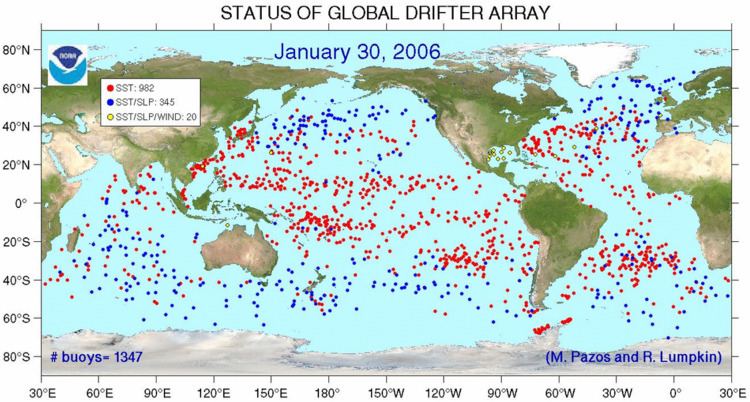 | ||
The Global Drifter Program (GDP) (formerly known as the Surface Velocity Program (SVP)) is the principal component of the Global Surface Drifting Buoy Array, a branch of NOAA's Global Ocean Observing System (GOOS) and a scientific project of the Data Buoy Cooperation Panel (DBCP). The project originated in February 1979 as part of the TOGA/Equatorial Pacific Ocean Circulation Experiment (EPOCS) and the first large-scale deployment of drifters was in 1988 with the goal of mapping the tropical Pacific Ocean's surface circulation. The goal of the project is to use 1250 satellite-tracked surface drifting buoys to meet the need for an accurate and globally dense set of in-situ observations of mixed layer currents, sea surface temperature, atmospheric pressure, winds and salinity, as well as create a system to process this amount of data. The GDP program is also important because the horizontal transports in the oceanic mixed layer are relevant to biological and chemical processes
Contents
Drifters
Drifters began being deployed for the SVP project in 1979 and the current design was developed from 1979 to 1992 until the current design was created. The drifters are spherical surface buoys with a nylon drogue attached that allows for them to track the horizontal motion of water at an optimum depth of 15 m. One known source of error is the drogue breaking and the wind speed having more of an influence on the buoy. A tether strain gauge has been added to monitor tension of the buoy-drogue connection to resolve this issue. The original drifters are heavy, bulky (40 cm diameter), and expensive relative to the newer "mini" drifters that are smaller, (30.5 cm diameter) cheaper, and lighter because the hull contains fewer batteries. The surface float contains alkaline batteries, a satellite transmitter, a thermistor for sub-skin sea surface temperature, as well as other instruments that could be useful in measuring pressure, wind speed and direction and salinity. The drifters are deployed from research vessels, volunteer ships, and through air deployment. The drifters typically transmit their data hourly and have an average lifetime of ~485 days in 2001. Presently, there has been enough data gathered to observe currents at a resolution of 1 degree. Single drifters can be tracked with the name of the drifter.
Success of the Program
The data from the GDP has been used for oceanographers to derive maps of the lateral diffusivity and Lagrangian scales of velocity, length and time across the whole Pacific. It has also been used to observe the amount of plastic accumulation in the North Atlantic and Caribbean Sea from 1986 to 2008 and the impact that the plastic increase is having on the environment in the open ocean. Climatologists have used this open ocean data to create models that are able to produce model equatorial ocean currents comparable to observations based on this data that was not available before. These are samples of the most influential papers from a variety of fields, but the abundance of data over the extended amount of time that this project (and its predecessors) was able to produce have led to hundreds of other papers in these fields as well.
Organization and Collaborators
The GDP consists of three components. The component at NOAA's Atlantic Oceanographic and Meteorological Laboratory (AOML), manages deployments, processes and archives the data, maintains META files describing each drifter deployed, develops and distributes data-based products, and updates the GDP website. The component at the Scripps Institution of Oceanography (SIO) supervises the industry, upgrades the technology, purchases most drifters, and develops enhanced data sets. The third component is the manufacturers in private industry, who build drifters according to closely monitored specifications. The GDP collaborates with partners from numerous countries including Argentina, Australia, Brazil, Canada, France, India, Italy, Republic of Korea, Mexico, New Zealand, South Africa, Spain, United Kingdom, and the United States.
